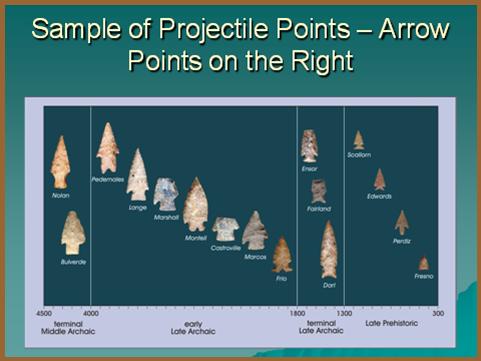Guide to SA Natural Areas & Greenway Trails
B. Area Cultural History
Dr. Steve Tomka, Director of the Archaeological Research Center at the University of Texas at San Antonio, wrote this point.
12,000 YEARS OF HUMAN OCCUPATION
Evidence of human occupation of Bexar County and the greater San Antonio region stretches back roughly 12,000 years.
NOMADIC HUNTER-GATHERERS
The earliest evidence of humans in South Texas consists of spear and dart points used by nomadic hunters and gatherers. The darts (large arrows or light spears) were thrown using an atlatl or throwing stick. These people hunted large game such as mastodons and mammoths. With the disappearance of the large animals, these hunters switched to smaller game such as deer and antelope, and they began to include roots, tubers, and seeds in their diet.
Small, widely-spread, nomadic groups returned regularly to territories they claimed as their own. With an increase in population, groups settled into small regions, with large cemeteries appearing around 3,000 years ago. Trade with neighboring groups was initiated, and inter-group violence occurred. Food sources remained constant, fluctuating only with changes in bison populations.
CERAMICS and BOW & ARROW
Two major changes occurred about1,200 years ago. Ceramic vessels came into use for cooking, and the bow and arrow became the primary hunting weapon.
Have we experienced technological changes in our lifetimes that have a major impact on how we live and behave?
Native groups in South Texas remained nomadic due to the lack of running streams south of the Nueces River. Lush resources along the San Antonio River basin permitted native groups to coalesce along the upper reaches of the river in what is known today as Brackenridge Park and to establish long-term settlements.
SALADO CREEK CAMPS
The San Antonio River may have been an artery of transportation, with groups traveling long distances in canoes. The first Spanish visitors spent seven years in Texas between 1528 and 1535. Later, members of the Lipan Apache, Comanche, and Tonkawa tribes roamed the region. They often camped along Salado Creek, which runs through Phil Hardberger Park. Eventually, Spanish missions and forts were established across South Texas and in present-day Bexar County. Native groups lived and worked in the missions, leading to the assimilation of many groups after the secularization of the missions in the early 19th century.
DOCUMENTED SITES IN OUR NATURAL AREAS
Archaeological surveys in Friedrich Park, Eisenhower Park, and Walker Ranch document these areas as camp sites, hunting spots, and quarry areas for good quality chert. The chert was used to make hide scrapers, arrow points, and various tools. Chert “blanks” from local quarries were traded across the state. Stone tool fragments, burned rocks, and animal bones indicate permanent encampments on the banks of creeks.
What is the true significance of archaeological sites and the artifacts found within them?
NO ARTIFACT COLLECTING
From artifacts found within the natural areas, archaeologists are able to reconstruct the site to identify who made the tools and the time of their fabrication. Surface artifacts reveal information about trade patterns, technology changes, and landscape uses. Loss of these artifacts means the permanent loss of information about the past. The collection of artifacts on city, county, and state lands is prohibited by law. Unlicensed artifact collection may lead to prosecution, which can result in fines or imprisonment.
